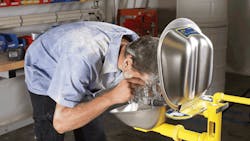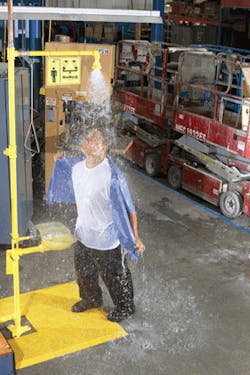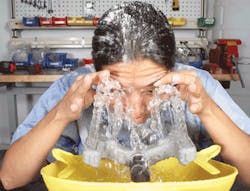They may not always be easy to see, but nearly every industry has eye hazards. That's important considering that the eyes are the body part most vulnerable to injury in the workplace. An astounding 2,000-plus eye injuries occur on the job every day, according to the U.S. Bureau of Labor Statistics, and almost 100,000 incidents lead to temporary or permanent vision loss. During 2008, 3.7 million injuries and illnesses were reported in private industry workplaces.
Impaired vision is an enormous cost to the injured – and there's a steep business cost, too. The Bureau of Labor Statistics estimates businesses lose more than $300 million dollars annually due to these unfortunate accidents, once factors such as medical expenses, lost production time and workers' compensation costs are calculated.
See Also: Personal Protective Equipment (PPE) Safety Standards
Wearing safety glasses and protective clothing is required by OSHA. But when these items fail to protect, immediate flushing of the eyes and skin is crucial. Immediacy is key – after 10 seconds of contact, the chances for a full eye recovery are slim.
Having a solid emergency plan with the proper plumbed emergency fixtures – eye washes, eye/face washes and drench showers – installed in the correct locations and ready to go is the next line of defense. The following guidelines discuss the placement, installation, standards, requirements and product features relative to emergency fixtures.
Emergency Response Jobsite Assessment
The placement of plumbed emergency equipment begins with a thorough jobsite evaluation of a facility to identify high-risk areas, potential hazards and emergency needs. Ideally, these evaluations should be conducted yearly to ensure the correct type of emergency equipment is in ready and workable condition. Some emergency equipment manufacturers offer free jobsite evaluations and can help assess potential problems.
First, determine the type of protection that is needed. Facilities that have a particulate risk with grinding, sanding or machining operations need plumbed or portable eyewash units. Workers who could be splashed with a corrosive chemical or exposed to a chemical vapor, meanwhile, need access to a drench shower to rinse their entire body.
Eye Washes vs.Eye/Face Washes
Next, assess the facility's emergency eyewash and drench shower needs. Appropriate equipment should be selected based on the level of exposure to workers and how many will be affected:
Emergency eyewash stations are effective for spills, splashes, dust or debris likely to affect only the eyes, and are designed to provide a controlled flow of water to both eyes simultaneously. Eyewash stations require an uninterrupted, 15-minute supply of tepid water. Plumbed units can supply a greater volume of water available to the user-between 7.5 and 19.0 liters (2.0 and 5.0 gallons) per minute. A minimum water pressure of 30 pounds per square inch (PSI) should be supplied.
In situations when larger areas of the body may be at risk, a drench shower quickly flushes a larger portion of the body but is not appropriate for the eyes, while a combination eyewash and drench shower is designed to flush the eyes and rinse larger areas of the body.
Location, Location, Location
A safety or heath advisor should be consulted in locating fixtures correctly to ensure all workers are protected. It also is essential to reference the ANSI Z358.1 emergency equipment standard for equipment installation, testing, performance, maintenance, training and use. ANSI provides the following placement guidelines:
- A drench shower, eyewash or combination unit should be located within 10 seconds of any worker at risk for chemical exposure. The distance a worker can travel in this time frame is estimated to be 55 feet.
- The equipment must be on the same level the user is working on. If there are doors between the hazard and the fixture, they must swing in the direction of travel.
- If the worker's ability to walk or move might be impacted by the chemical exposure, the fixture should be placed closer to the worker.
- If highly corrosive chemicals are used, the drench shower or eyewash should be placed immediately adjacent to the hazard.
- If a potential chemical spill in an area is likely to affect multiple workers, a sufficient number of fixtures should be in place to prevent one worker from having to wait 15 minutes while another is drenched.
- Safety fixtures also must be clearly identifiable and easy to reach:
- The area around the fixture should be well-lighted.
- Each fixture should be identified with a highly visible sign. Yellow is easiest to spot in a busy industrial environment.
- Eyewash sprayheads should be a minimum of 6 inches from walls or obstructions to allow the user clear access for eye flushing.
The area for flushing under the drench shower should be unobstructed. The only exception is the eyewash on a combination drench shower and eyewash fixture, when eyewash is placed in line with the drench shower to allow for simultaneous use.
Water Temperature
ANSI requires that a 15-minute flow of tepid water be supplied to emergency equipment and suggests an incoming water temperature between 60° and 100° F.
Thermostatic mixing valves (TMVs) blend hot and cold water to a specific set point and deliver tempered water to emergency fixtures. There also are on-demand water heaters specifically designed to provide water to emergency fixtures. If the tempering design involves the selection of an emergency TMV, be sure to select a valve that is an emergency thermostatic mixing valve and not a standard valve. Emergency TMVs are designed to allow for a continuous free flow of cold water if the hot water supply is interrupted or runs out.
When selecting a tankless heating system, look for a system that specifically has been designed for use in emergency eyewash and drench shower systems. Consider systems that have a low pressure drop (10-12 pounds per square inch); this capacity will curb potential post-installation complications due to a sudden pressure drop. Finally, a tankless water heater that uses an incoloy-sheathed heating element can protect internal components and provide longer element life, increasing operational reliability.
Several key improvements to flow control, coverage and efficacy of eye /face washes and drench showers have emerged in the past few years:
Washdown coverage. The newest eye/face wash fixtures are engineered to deliver a more uniform and complete rinse pattern to reach the entire face. The improvement covers more of the face than ever before and provides for a faster and more effective rinse over the affected area. Older shower designs push the flow of water to the outer rim of the showerhead, creating a hollow space in the center of the pattern that can miss affected areas. The new shower designs work together with a pressure-regulated flow control and the spinning motion of water, creating a spray pattern to rinse off the injured as quickly and thoroughly as possible.
Cleanliness. Due to stagnant water left from required weekly testing, tampering and other misuse by workers, eye/face washes can become contaminated with dirt and bacteria. Newer eyewash designs come equipped with either plastic or stainless steel dust covers that shield the entire bowl. Opening the dustcover cover starts the flow of water immediately, giving the user immediate relief. Additionally, newer eyewashes incorporate a self-draining design that eliminates any stagnant water in the system. They also feature clearly separated supply and waste pipes with all supply connections above the bowl to prevent cross-contamination from the clean inlet and wastewater.
While the basic requirements for eye/face wash and drench shower technology haven't changed, the product choices have, allowing organizations to greatly improve worker protection. Consulting with a third-party safety consultant or an emergency equipment product manufacturer can help engineers, designers and owners research and formulate a solid safety plan involving plumbed emergency fixtures to provide peace of mind for all.
Ryan Pfund is product manager, emergency fixtures, for Bradley Corp. of Menomonee Falls, Wis., a USGBC and ISEA member and manufacturer of locker room products, plumbing fixtures, washroom accessories, partitions and emergency fixtures.
Ryan Pfund is product manager, emergency fixutres, for Bradley Corp. of Minomonee Falls, Wis., a USGBC and ISEA member and manufacturer of locker room products, plumbing fixtures, washroom accessories, partitions and emergency fixtures.


